The projects 'West of Last Chance' and 'On the Plains' evolved over a long period of time. Please give us some history regarding your initial interests and how they developed during the last two decades.
Peter Brown (PB): For a set of reasons I don’t fully understand, I’ve always been drawn to high, wide and open American spaces. Out of simple curiosity I went to a therapist once to get at the root of this (I’d been photographing the High Plains for a decade or so at the time) and the man told me not to worry about it, to be thankful for the passion. Just follow your interest, he said. And there’s a nice line from Rumi: “Don’t analyze enthusiasms”.
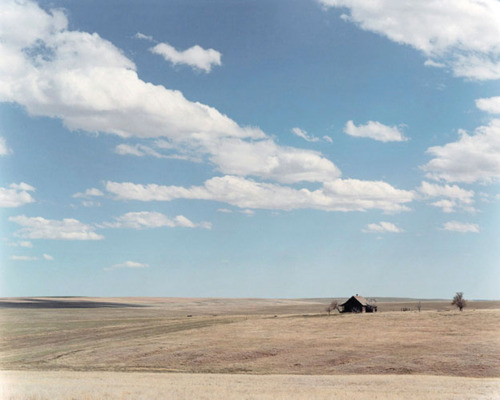
© Peter Brown from the series 'West of Last Chance', Prairie Home, Last Chance, Colorado, 2006
But let me try for just a bit: I grew up on the east coast and moved west to California after eighth grade and was immediately struck, on that first trip, by the open space in the middle of the country. It went on and on and I loved it. My interest in a superficial way goes back even further - to a romance with The West that American culture had in the fifties and sixties when I was growing up in the east. Kids books, movies and television were filled with The West. And I signed on – reading, seeing, thinking, imagining. And it took a deep hold when my family moved to California from the east when I was thirteen. We kept a summer place in western Massachusetts, so I traveled across country again and again, twice a year for many years – riding first with the family, then hitch-hiking for the adventure, and eventually driving myself and my friends.
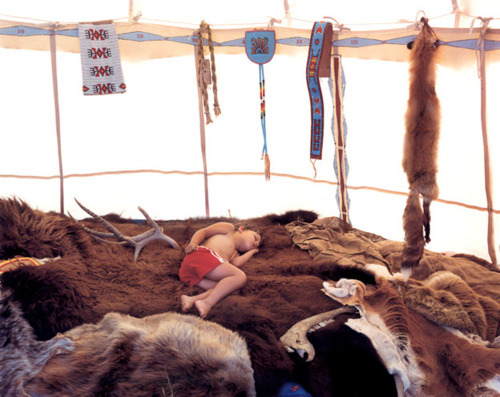
© Peter Brown from the series 'West of Last Chance', Sleeping Boy, Soldier Summit, Utah, 1987
And then, after college (English) and grad school (Photography) and after moving to Houston in the early eighties to teach, I made a photographic commitment to this huge space. And it’s turned into a lifelong bond. So I’ve bounced up and down the plains for many, many years. I’ve loved the complex history, the roads, the little towns, the space, the color, the people, the animals, the sky, and the peace and challenge that this space can give.
The draw is both cultural and geographical. And the combination has always felt right. It’s felt right as a place to be: there’s a sensuality to the air and the dry heat that’s wonderful; there’s a drama to the weather and a seductiveness to the light and color that I can’t get enough of. And it feels right as a way of expressing what I want to say about the America I live in, and my general attitudes toward life.
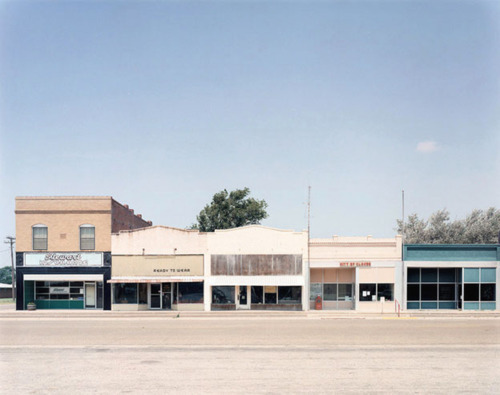
© Peter Brown from the series 'West of Last Chance', Shop Fronts, Claude, Texas, 1995
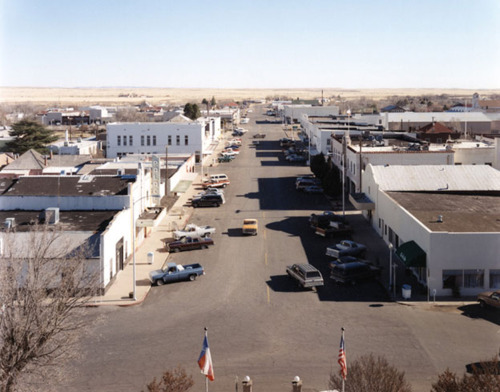
© Peter Brown from the series 'On the Plains', View from the Courthouse, Marfa, Texas, 1991
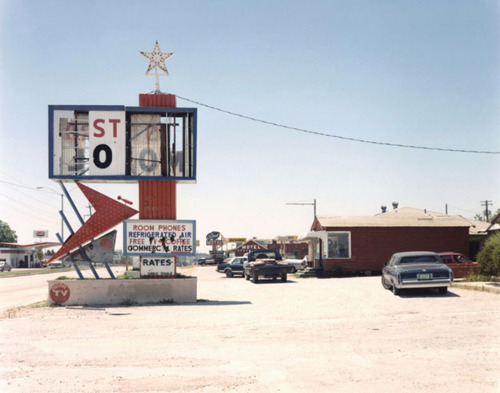
© Peter Brown from the series 'On the Plains', Entrance to Ardmore, Ardmore, Oklahoma, 1988
Everything I need artistically is on the Plains, and so I continue return. My friend Kent Haruf wrote in our collaborative book West of Last Chance: “You have to know how to look at this country. You have to slow down. It’s not pretty, but it’s beautiful.” So I go, both to replenish myself and to give voice to the feelings that the space evokes.
I think literature and photography often have much in common. Like a writer of fiction it seems you are interested in transforming your observations into imagery that can transcend this particular place.
PB: When I get to the base of my work, the photographs are not just about the middle of America. As a group, they’re about human culture and the natural world – wherever people and land come together. I have talked with Kent about this. He is the author of the novels Plainsong and Eventide (among others) and he grew up in small towns in Colorado. He knows the Plains thoroughly. And he has spoken of his annoyance at being pigeon holed from time to time as a “regional writer” because he sets his books in a fictional Plains town. His feeling, and it’s mine too, is that any place can be used as ground for one’s perception, if that place is the right place. It’s a matter of discovering a locale that fits and works with what you want to say. The Plains I photograph certainly exist in their own right - and there’s a documentary aspect to what I do - but the High Plains and those towns can serve as signifiers for much, much more.
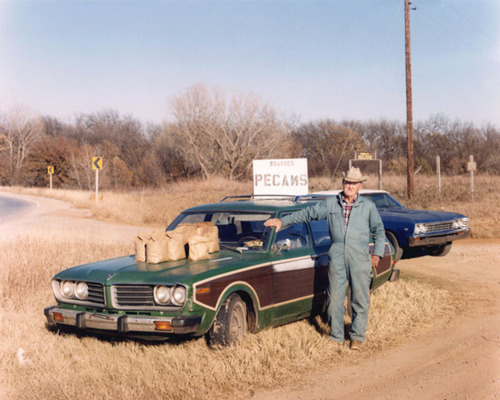
© Peter Brown from the series 'On the Plains', Pecan Salesman, Apache, Oklahoma, 1986
I began creative life as a writer and I’ve continued to write as well as to photograph. And I have friends who are writers – and I think the connection between writing and photography (particularly fiction for me) can be strong. Walker Evans, at the end of his life talked of a “lyric documentary,” a style that bridges subject matter with a photographer’s psyche. And I like that. My work is not just about place in a New Topographical way, it’s also about feeling and interpretation.
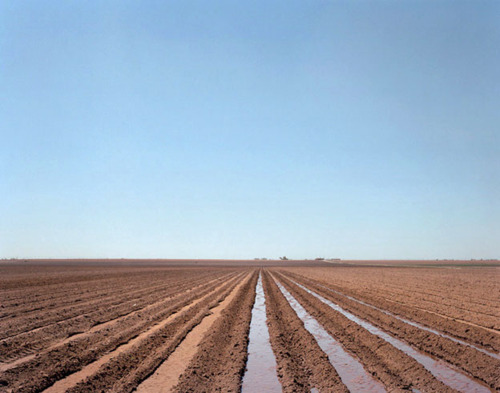
© Peter Brown from the series 'West of Last Chance', Irrigated Field, Levelland, Texas, 2002
In my first book, Seasons of Light (a book composed primarily of interiors) I wrote with each image. And I “read” each image and wrote about the photographs in a variety of ways. The point I was trying to make was that photographs are multi-faceted things and can end up having wildly different meanings depending on the mind engaging them, even a single mind at different times.
A fellow Landscape photographer recently commented to me about his interest in being made aware of weather in contemporary landscape photographs and how it is frequently downplayed. Your skies are an important part of many pictures. It is because of the way you present the cloud’s temporality that we better understand the slow time scale of the Land itself.
PB: Clouds were a photographic revelation to me. They are the moving element in a landscape that is often static. I began my work in the Plains with a 2 ¼ inch square camera with a through-the-lens viewfinder and photographed for three years before moving to a 4x5 view camera that better corresponds to the shape of the Plains. When I changed to the big camera I became much more involved with the horizon line. And the upper part of the photograph, the sky, became even more important to the composition of the image – and clouds became newly challenging and mysterious.
You cannot see through the back of a view camera when you’re taking a picture, so at the moment of the shutter release you’re actually photographing blind. Capturing clouds at the right moment brings a strange and almost street photography aesthetic to what I do. It pins down a piece of time within a wide continuum. And it speaks of present time in relationship to the land in a light and momentary way.
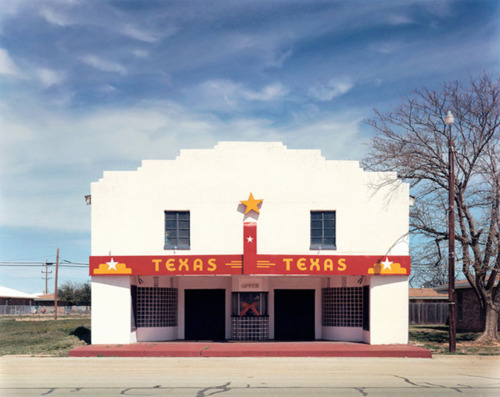
© Peter Brown from the series 'West of Last Chance', Texas Theater, Bronte, Texas, 2003
A favorite picture of mine is called Dimmitt Meat Company. Back in 1992 I spotted a strange little cloud as I drove into Dimmitt, Texas. It looked like a cross between a cartoon balloon and a piece of punctuation from some long lost language, and I drove through Dimmitt looking for a place to put it. As I rounded a corner, the Dimmitt Meat Company appeared – and there was the cloud, balanced momentarily above its door. I was out of my car in seconds, setting up the large camera as quickly as I could. And I managed four shots before it moved on.
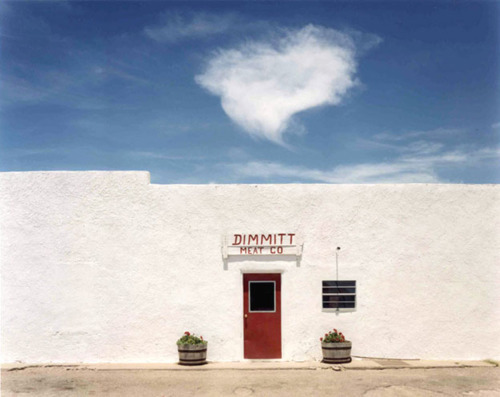
© Peter Brown from the series 'On the Plains', Dimmitt Meat Company, Dimmitt, Texas, 1992
The cloud is what makes the picture work. It’s what gives it its individual moment. Without the cloud, the photograph is just a curiosity. And this is the case with almost all of my open space photographs as well. The sky is elemental to the landscape of the Plains. And clouds or their lack give images time, depth, form and sometimes meaning.
I see the influence of Walker Evans in your pictures. Could you talk about his influence and any other artists that have influenced your work?
PB: Walker Evans is perhaps my favorite photographer. We have two Evans’ up in our living room and they’ve been in our homes for as long as I can remember. Both were taken in 1936 in Alabama. One is a light filled interior of a church, and the other is F.M. Pointer, Old Reliable House Mover and Fish and Vegetable Stand. I have over twenty books by and about Walker Evans and a variety of other prints. So yes, I’ve been influenced by Evans and his work. I never met him, though I had friends who studied with him at Yale at the end of his life.
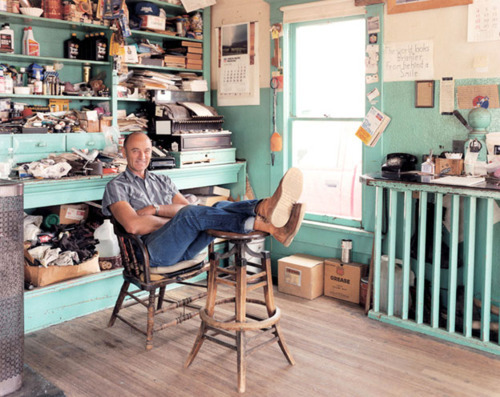
© Peter Brown from the series 'West of Last Chance', Al Meininger, Orchard, Colorado, 1995
His way of dealing with the vernacular American landscape is something that’s ingrained in me and has been a part of the way I photograph for decades. He has a way getting out of the way and letting the subject matter speak for itself that I find appealing. (Although he remains an element in each shot.) I like the way he fills the frame. And I like the way he chooses bits and pieces of America that have a kind of “Walker Evans Seal of Approval” stamped on them. He may not like what he’s photographing but he’s clearly fascinated by the subject matter. And the act of photography itself seems filled with care. It’s somewhat the way I feel Robert Adams photographs those things that he finds tragic. It’s with the same energized attention exhibited when he’s confronted by beauty. I remember years ago, Gary Winogrand saying on first seeing Walker Evans work that it demonstrated that human intelligence could be a part of photography. That photographing wasn’t just intuition, but that clarity of mind and rational thought could be integral as well.
I like Evans’ intelligence, I like the fact that he was a writer as well as a photographer and I like the fact that he came from the Midwest, went east, invented himself and became one of a handful of artists who showed us what the thirties looked like. He wasn’t from the south but he did his best work in the south and it lasts. And I like that.
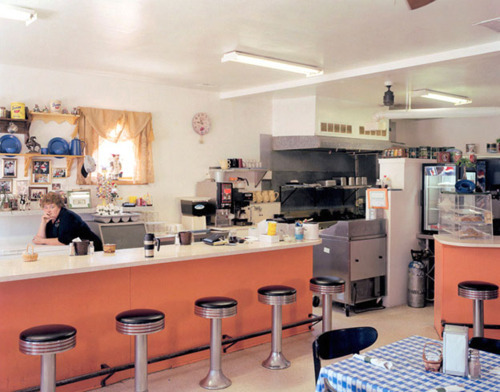
© Peter Brown from the series 'West of Last Chance', Tin Can Diner, Venango, Nebraska, 2005
When I first moved to Texas, a student of mine was trying to place me and finally said: “You’re nothing but a Yankee gone out west and come down south.” And I am. But since coming south, I’ve headed north. Back and forth, up and down the Plains. And Evans’ example of finding a place that corresponds to something within, a place that one is not native to, but responds to deeply to has given me licence for many years.
Other artists: Robert Adams has been a friend and an influence for a few decades now. I admire him for many of the reasons I like Evans. William Eggleston certainly is there for his color and choice of American subject matter. Lee Friedlander for his daunting production – the way he keeps on, and the remarkable way that he frames whatever nominal subject matter that catches his eye. Joel Meyerowitz influenced me early on in his work on the Cape, and his thought on color photography. My wonderful teacher at Stanford, Leo Holub for his gentleness, his respect for all things and his wisdom. Of my generation particularly: Stephen Shore, Richard Misrach, Joel Sternfeld and Steve Fitch. And then of course Atget, Robert Frank, Cartier-Bresson.
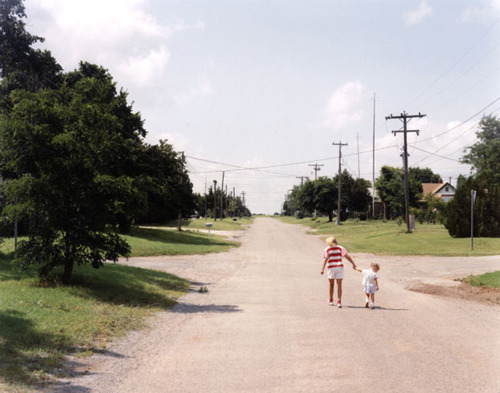
© Peter Brown from the series 'On the Plains', Sisters Walking, Big Bow, Kansas, 1991
I travelled in the late eighties and early nineties with the cultural geographer John Brinckerhoff Jackson, the man who pretty much invented “Landscape Studies”. We were paired in a grant through Rice University and I learned an enormous amount from him traveling through the Plains. He was a salty and brilliant old man and in his eighties at the time. I was in my mid thirties and we got along in the best ways.

© Peter Brown from the series 'West of Last Chance', Charley's Market, Ashby, Nebraska, 1993
And writers: my good friend Kent Haruf, our mutual friend Mark Spragg, Barry Lopez, John McPhee, Jim Harrison, Tom McGuane, Wendell Berry, Marilynne Robinson, Rick Bass… Many others. I may have been influenced by writers as much as by photographers. A few more in no particular order: Hemingway – particularly his descriptions of landscapes and the clarity of his language, Wallace Stegner, Jack Kerouac – who got me on the road and on my own, Alice Munro, Geoff Dyer, Edward Abbey, Larry McMurtry, Ian Frazier, Mari Sandoz, Willa Cather, Tim Egan – and I could go on…
The Façade and this particular landscape of The Plains are very different and maybe opposite forms of pictorial space. They are complimentary in these series. The facades are the persona of some of the inhabitants while the landscapes offer the freedom of an unobstructed vantage point. How do you understand the three main facets of the work, which are: the landscape, the facade and the interior portraits?
PB: I often think of my Plains work, the two books, as extended trips to town. 'On the Plains' was just that. It begins in open country, moves to a very small town, on to a larger one and then off into space again. 'West of Last Chance' is broken into chapters, but the idea of moving from open space to town, to interior space and out again remains. My Plains work is of a piece, although the books make different sorts of statements.
Open space is open space and the challenge is to reproduce the vertiginous feel of it, the giddiness, as well as to make the photographs pictorially interesting. And that’s a dual challenge. The landscape is as minimal as one can imagine. So color, line, patterns in dirt, shifts of agricultural texture, clouds, weather, very nuanced things all come into play. As does scale as far as a sensory experience of the Plains goes. Window sized prints have a very different impact than small images from a book.
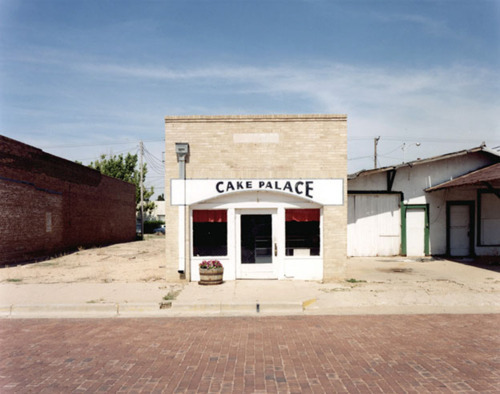
© Peter Brown from the series 'On the Plains', Cake Palace, Tahoka, Texas, 1994
Basically, I’m interested in a literal depiction of that space and I’m interested in what people have done with the land: the ways they have used and marked it. And beyond this, I move into a variety of individual things that are hard to define in specific ways but which do crop up in my work: the spiritual aspects of space, my political point of view, environmental concerns, the way color and light affect interpretation etc…
The facades relate directly to Walker Evans – and to Atget as well. There are a number of dead-on shots of false front buildings that Evans made back in the thirties that I’ve had in my memory forever. I think it’s the best way to photograph these structures. And I think the buildings do become representatives of people in a way. I like the directness of them and I like the self identification: a bank, a bakery, a law office, a barbershop, a café, a meat company, a bean plant, a paint store, a lumber yard – whatever. There’s a handmade quality about many. Each makes a statement that reflects ownership and personality.
And there’s also often a good-natured quality to the facades that reflects a humor that many Plains people seem to possess. A dry wit. You’re in on a functional joke and they’re creating the joke and whether it’s “H.A.C. BRUMMETT LAWYER” – huge letters on a tiny building across from the courthouse in Dickens, Texas, or the grandly named but minute “Cake Palace” in Tahoka, or the arched “Halfway Cemetery” in Halfway, Texas - a gentle wit in a mammoth space is there for all to see.
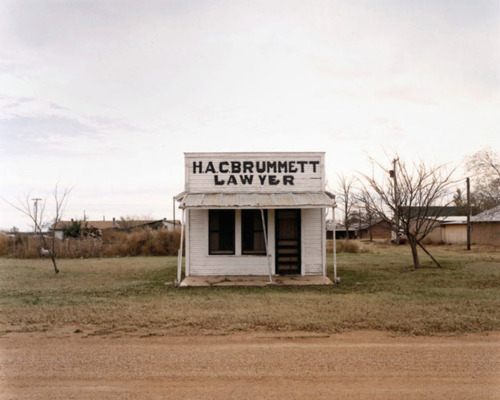
© Peter Brown from the series 'On the Plains', HAC Brummett, Lawyer, Dickens, Texas, 1986
As for the interior portraits. They’re generally of people I’ve gotten to know a bit and who seem emblematic of the place and the land. I like environmental portraits for the simple reason that you get to know more about the person. Interiors say so much, particularly if they’ve been lived in for some time as most of these have. The portraits are somewhat new for me and I want to do more of them. The people are of the land - of the place - and it shows in their faces. There’s finally little differentiation between them, their homes, their towns and the space that surrounds them. It’s one piece, one world.
You have had a few books published. Could you talk about your thoughts regarding books versus the print on the Gallery wall? Has the experience of being published changed the way you think about picture making?
PB: As I’ve said, the print on the wall, particularly if it’s large, can have immense impact. It functions as a window as much as two a dimensional thing and it transmits a feeling of being at a specific place. I like my photographs printed 28x35 inches and beyond - although I’ve also done gridded work which puts a variety of small prints in context. Exhibitions always create an environment for images because prints are hung with others that relate. But the experience is generally not a narrative one, but more a set of contemplative moments that may or may not merge. And prints are often squeezed into a space that may or may not work well with a normal progression. But I do love seeing my work at large scale. It comes close to reproducing the feeling I had when I was photographing.
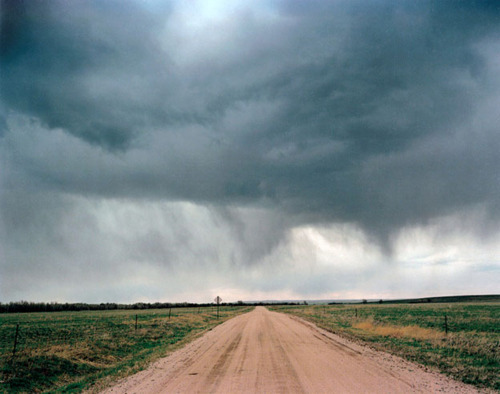
© Peter Brown from the series 'West of Last Chance', Walking Rain, Limon, Colorado, 2006
Other than in my very early years when I was thinking of my work primarily in single image “Art” ways, I have always planned my work in terms of books. I grew up in an academic family. My father was a theologian and books were holy things. The only objects I never feel guilty about buying are books. My father, with deep Scottish Presbyterian roots never was comfortable spending money – apart from his books - and this legacy was passed on to me. So I love books. I’ve always thought of my Plains work as narrative.
The way I photograph is to put myself into a place where I know I can make related images – a place that will take a long time to exhaust. And each time I think that I’ve exhausted the Plains, I take a few years off, do other things, feel bereft and come back energized. I hit the road, begin to see in a new way, understand how much I still have to learn - and I fall in love with that space and that light and those storms and that myriad of little towns all over again. And I can’t see that ever changing.

© Peter Brown from the series 'On the Plains', Controlled Burn, High Island, Texas, 1988
---
LINKS
Peter Brown
United States
share this page